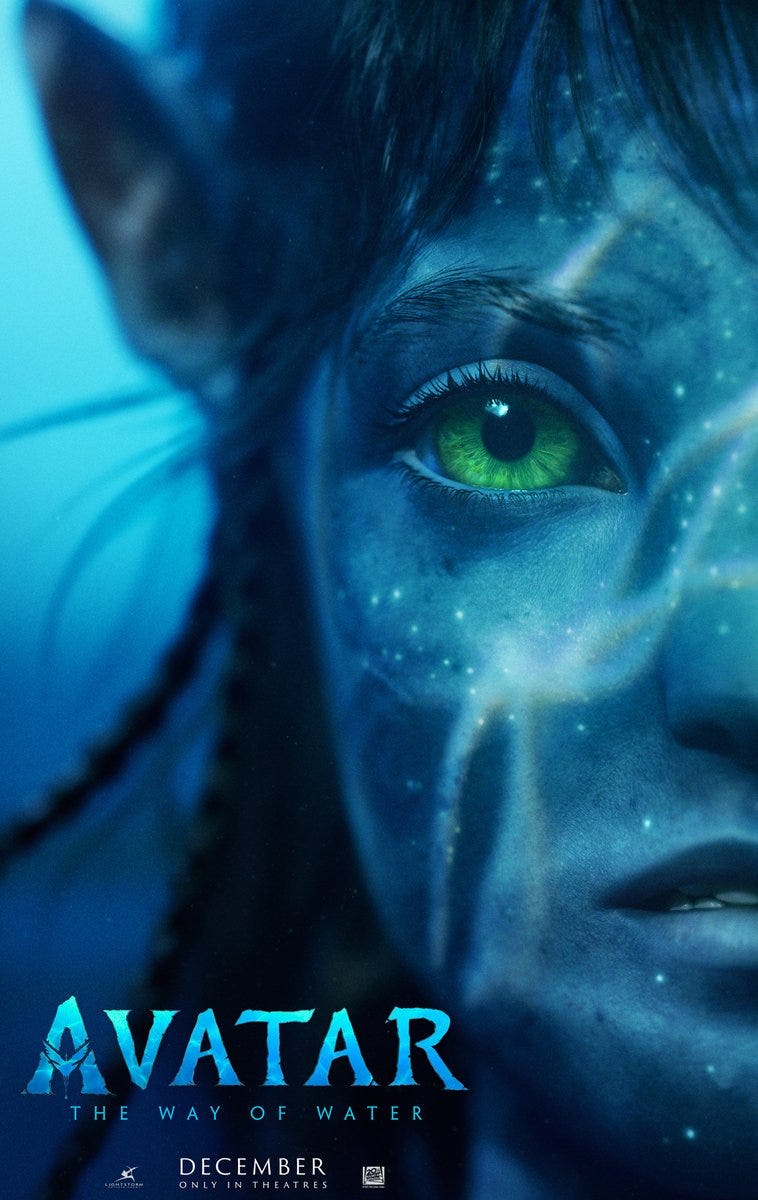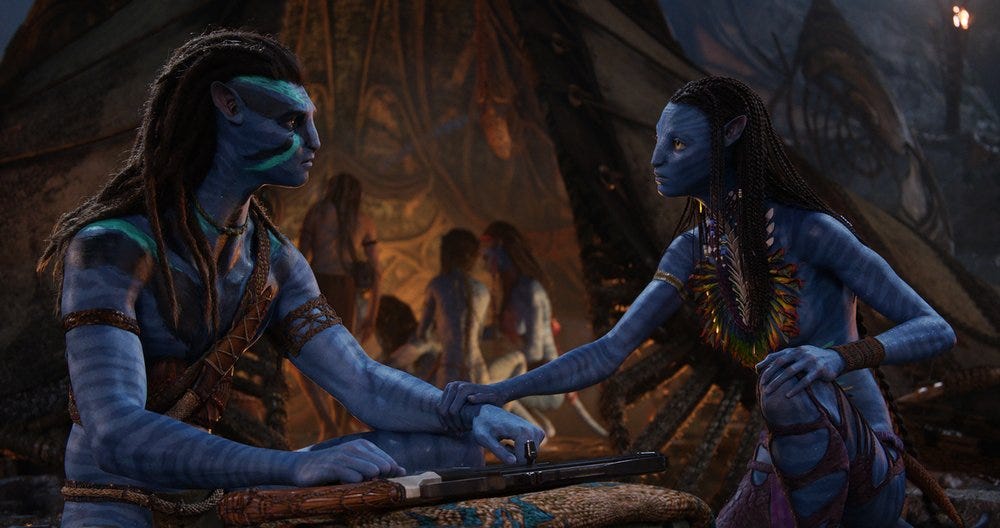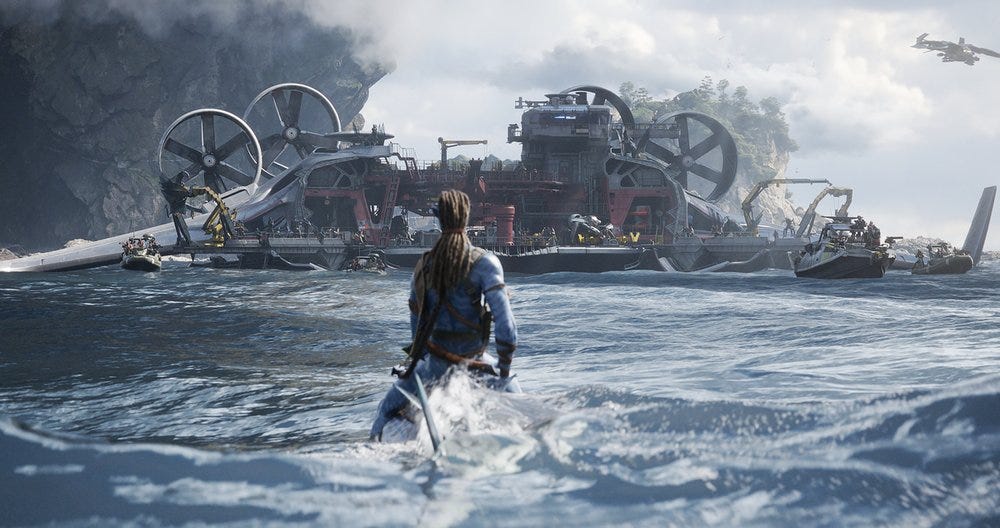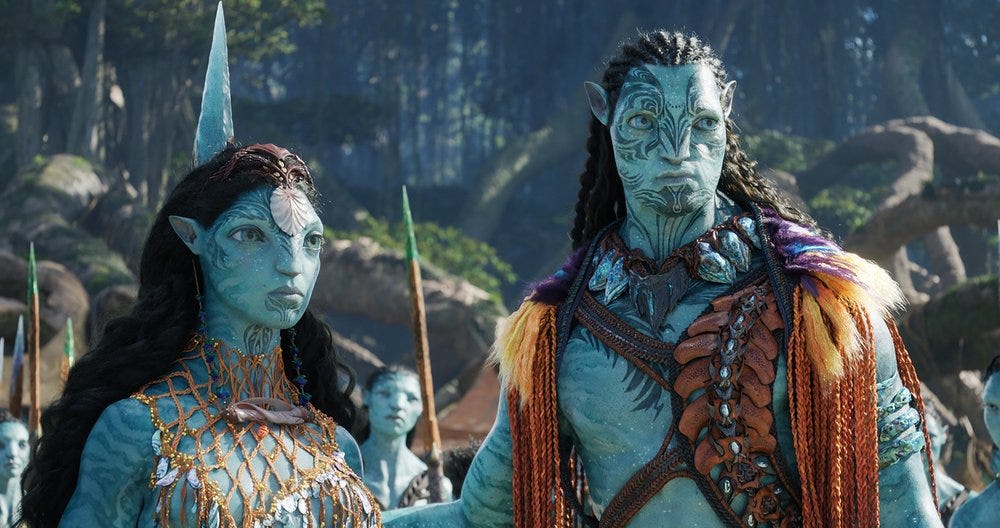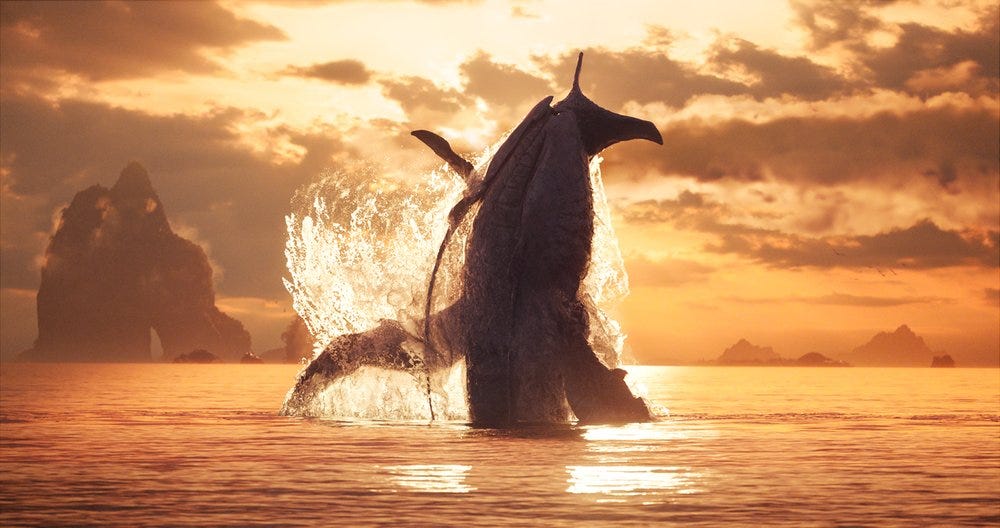Avatar: The Way of Water (PG-13, 20th Century Studios)
Sometimes there are movies that demand to be seen in theaters. Most of the time those films are described as blockbusters, and their genre is similarly limited to action, sci-fi, occasionally horror. These movies stand out because the experience one can have at the theater is intended to far surpass the experience most are possible of having in their living rooms. Most often i think of things releasing in the MCU, Star Wars, Dune, Blade Runner 2049, Gravity, The Quiet Place. All movies made quantifiably better by experiencing them in the largest format with the best sound you can find. Few movies live up to the claim they “must be seen in theaters!” Perhaps this is because theater attendance is harder to consistently draw, on the heels of a COVID lockdown and the world adjusting its parameters for “reasons to go out.” As a parent with two kids, there has to be something truly special about what I am going to see to make me feel as if I absolutely must venture out and spend money to be a part of the experience. James Cameron’s Avatar: The Way of Water is precisely one of those films.
When the first Avatar released, way back in 2009 (you’re welcome for the reminder you’re old) it was an immediate phenomenon. Its praises filled the papers and blogs, dormitories and hallways. Firstly, it was beautiful. A visual spectacle that very few movies would have the capability of replicating. Secondly, its story, while borrowed, was well executed. In the decade since its release people have grown louder in their discontent on that latter front, but despite it being “another Fern Gully (mind you, a movie very few people I know have actually seen on account of generational difference)” it’s hard for me to say Avatar is bad because of its plain mimicry of another tale. After all, it isn't a plain mimicry, changing bits and bobs, adjusting outcomes, resulting in something deeply familiar, but not exactly plagiarized.
When The Way of Water released its first trailer, these were the first dissenting opinions I encountered. People are allowed to not like things, I want to make that very clear. So hearing the aforementioned complaints, I largely responded with nods, and acknowledgement. Those detractors should be glad to know Avatar’s long-awaited, long mystery-shrouded sequel, doubles down on its visual prowess, and tells a story far more interesting, much more unique, and deeply moving.
We pick up with Jake Sully and Neytiri (both reprised by Sam Worthington and Zoe Saldana) more than a decade after the first movie. We see our two heroes starting and raising a family, building up the Omaticaya people in the hanging mountains, and living generally peaceful lives, until they discover that humans are returning to Pandora. Several colony ships land, scorching the forest beneath them, and bulldozing a path to set down a new operating base. This is only the first of a couple “of course they are” moments in the film’s first act. The RDA (Resources Development Administration) had to come back, people are too greedy to leave the gem of Pandora to itself after just one failed attempt. Despite the massive nature of that failure, they return with even more hardware, people, and a renewed vigor. Aboard their vessels, much like in the first film, are humans that have been altered via the Avatar program, however unlike Jake and his crew of scientists before, these Avatars are built from cloned minds, no longer requiring a human anchored to a neural weave in a secure location. Also unlike Jake and his crew, these Avatars are soldiers, through and through. This is our second “of course they are” moment. These Avatars are recognizable, loathable members of our last crew of RDA mercenaries. They have one mission and one mission only. Eliminate Jake Sully.
The beginning is a little slap-dash. So much is set up in the first thirty minutes you would be excused for letting your head spin a little. But where this Avatar film then excels, is in its ability to take this information and run with it for the next two and half hours, without another moment of overt exposition. It quickly becomes very obvious that what the first film sought to do was lay the groundwork for a universe we would be returning to frequently. Therefore it begins to feel like the semi-familiar story beats in the first film existed far less to enthrall us with a unique tale and far more to ground us in an alien place with a familiar story. A familiar story we would be able to recall and remember, fundamentally, without having to do a lot of mental gymnastics. Where Avatar: The Way of Water takes its characters is intimately entertaining and almost entirely unburdened of the responsibility of making you understand how this world works. This is what Director James Cameron does best. We know this by his body of work. Aliens is a seminal work, one comfortable with taking the ample exposition of the first film and turning its premise on its head, navigating a brilliant transition from sci-fi/horror to sci-fi/action/horror. Terminator 2: Judgment Day is a pulse-pounding follow up to a movie with a tough premise to fully grasp. Yet, by the time the second film kicks off, we are fully onboard. Cameron thrives in built spaces. It’s one of the reasons I will always be sad he never got a chance to make a Star Wars sequel, though Tony Gilroy and the Rogue One/Andor pair are doing their very best to follow closely in his footsteps.
Quickly, with humans returned to Pandora, and an Avatar kill-squad on the hunt for Jake and his family, The Way of Water catapults us, along with the films First Family, into anxiety inducing waters. Jake and Neytiri take their family and flee to the island tribes, appointing a new leader of the Omaticaya and introducing themselves to the Metkayina, a Maori-adjacent people who aren't exactly thrilled these forest people have come to their lands, but respectfully offer them a place to stay. This immigration/refugee dynamic is fraught with perils and challenges, as Jake and Neytiri’s children work to learn the ways of the Metkayina, as well as dodge insults thrown at them by other children because of their mixed-blood heritage. This is difficult terrain to tread, but I think Cameron and his writing team did a tremendous job. While you grow ever more frustrated by the petulance of children, you also understand (and have constantly seen in real life) the struggles of people to accept differences among their familiar places. The Sullys are outsiders, the Metkayina strange and complicated to them, and as each learns more about the other bridges of familiarity are built at the same time resentments start to foment.
Of course our antagonists find their way to the Metkayina tribes. Of course they are oppressive in their interaction with the island nations. Of course the Chief harboring Jake and his family are displeased the tree-people’s conflict followed them out to the islands. But where The Way of Water pushes through this anticipatable escalation is, once again, in its ability to put convincing performances front and center, surrounded by incredible visual plating. As the action rises you find yourself on the edge of your seat not just because the action is well paced, but because you have been given a stake in their victory. You feel their anger, you sympathize with their fury.
All of these things come together to create a fantastic piece of science fiction. Specifically the kind of science fiction that has the ability to reach broad audiences because, despite its dense history and extended length, it will ring familiar for a great deal of people. And to add to this execution of plot, premise, and prose, the visual spectacle that the first Avatar served to us is easily doubled in this sequel.
James Cameron famously waits for the technology he needs to be available before he makes his sci-fi epics nowadays. For the last twelve years, the constant question has been, “what needs to be developed, perfected, or prototyped, before Cameron changes the light from red to green?” Initially my estimation rested on the back of the Volume, Disney’s indoor, all LED light-wall set architecture projects like Mandalorian and Thor: Love and Thunder used. In an interview just before The Way of Water’s release, Cameron made it clear, he was waiting for water simulation technology to push forward. Folks, when I tell you I had to pinch myself throughout this movie because I continuously forgot that a ton of it was computer generated, know I am in no way exaggerating. With the title this movie has, it is safe for any moviegoer to assume a large portion of the movie is in or around water. At three hours and ten minutes long, I would estimate that water is present for more than three quarters of the film. Honestly, I’m not sure what water was real and what was entirely computer generated. Aquatic life, flora, particles, waves, condensation, literally all possible permutations of water and the organisms living within these habitats are shown throughout this movie and all of it is gobsmackingly beautiful. And this is saying nothing of the fact that most of this film’s characters are completely computer generated as well. There are five or six human characters with more than a few minutes of screentime, everyone one else is Na’vi. Still, I never felt pulled out of any dramatic sequence or intimate moment because I didn't believe what I was looking at was real.
Avatar: The Way of Water is a serene, emotional, and action-packed return to the moon of Pandora. A return twelve years in the making. When you think about what went into the development of this bit of cinema, it makes the mind reel. Videos are popping up all over the place adding context to the fabric. The fact that Kate Winslet trained to hold her breath underwater for seven minutes and fifteen seconds. The fact that CJ Jones created the sign language of the Na’vi for this film without corollaries to existing sign languages. And finally the fact that James Cameron and his immensely talented team did nearly nine years of R&D developing submersible housings for film quality cameras, pioneering underwater performance capture, and making Sony create a camera that he needed. Truly Avatar: The Way of Water is going to change the way a lot of things are done going forward, just as the first film did.
Sometimes you have to see a movie in the theater to get the fullest experience. If there was any film this year that fit this designation perfectly, it’s this one. Do yourself a favor: go see this on the biggest screen you can find. 3D or not, it will blow your socks right off your feet. What an experience.
@LubWub
~Caleb





